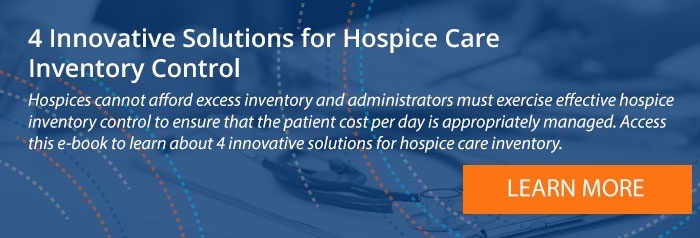August 30 is National Grief Day in the United States; a day set aside specifically to recognize the time it takes to heal from loss and also a reminder that closure comes in many forms. Healthcare providers, such as hospice or palliative care providers, offer counseling to aid in the healing process for those that lose loved ones through terminal...
Business Solutions for Hospice Care
In order to meet their goals and objectives, hospice providers rely heavily on their team of dedicated clinicians. These professionals keep the wheels turning on a day-to-day basis with support from medical specialists and the administration team. Furthermore, to carry out their work efficiently, clinicians need the constant provision of medical supplies in order to provide quality patient care. Business solutions for hospice need to focus on both maintaining and increasing the productivity of clinicians, as well as ensuring the supply chain operates efficiently.
Key Business Priorities
Key business priorities of any hospice include:
- Productivity: The ability of clinicians to maximize the amount of time they spend caring for their patients. This excludes time spent on other activities such as travel, administration and gathering supplies.
- Managing supplies: A constant supply of products, such as incontinence, wound care, patient hygiene and medication is needed. The manner in which clinicians are provided with supplies directly affects their productivity.
- Inventory management: Medical supplies represent a high cost item, therefore inventory management is a priority.
- Measurement and reporting: To be effective, performance should be monitored, costs controlled and efficiency measured.
Empowering Caregivers
Hospice clinicians must be able to make appropriate decisions, maintain the appropriate medical supplies for their patients and update patient records. To minimize the time spent on unproductive tasks, clinicians have three main concerns:
- Patient management: Clinicians should be able to update patients' records using mobile devices linked through the internet, and in this way, update central records.
- Ordering supplies: Clinicians need to order supplies directly using their mobile devices. If orders need authorization, these should be automatically routed for approval before being sent to the supplier.
- Direct shipment: To minimize unproductive time, it is essential that orders are shipped directly to patients' homes or to the supply room tagged for each specific patient and ready for pick up.
Business Management
To monitor performance and gauge efficiency, hospice administrators need access to various reporting tools:
- PPD: The cost per patient per day is widely recognized as a key indicator of hospice financial performance.
- Formulary control: Because each patient's primary needs can be readily identified, formulary control offers a simple way of managing what may be ordered without requiring separate managerial approval. In addition, providing the same products to each patient agency wide provides consistency of care.
- Inventory: It should be possible to monitor total inventory as well as remote inventories held by nurses and clinicians.
- Costs: Administrators need to be able to monitor overall and departmental costs and to identify trends and exceptions.
Solutions
Web-based or cloud inventory management and control solutions offer several important advantages over traditional on-premise solutions. Most importantly, they can be accessed from anywhere. This means that clinicians don't need to waste time submitting paperwork and can concentrate on their primary function, that of caring for their patients. At the same time, administrators have immediate access to information and can keep their fingers on the organization's pulse. Concordance's uCommand® supply chain management software offers all of the above and more.
Helping you stay in the know
As the use of palliative and hospice care increases, the need for services continues to grow. Traditional service portfolios have evolved and alternate payment models have emerged. Here is a review of some of the models.
In long term care, like other areas of patient care, it is essential to contain costs as much as possible while preserving the quality of care. There will always be a breaking point, at which it does not make sense to choose the least expensive option because it fails to perform adequately.





